更新几期Flink系的文章,有时间就写写,没时间就放放。之前做flink开发时候的一些认知还有心得,没有研究多深,大家多提意见,有问题的地方麻烦更正,本系列基于flink1.12。
Flink介绍
发展历史


官方介绍
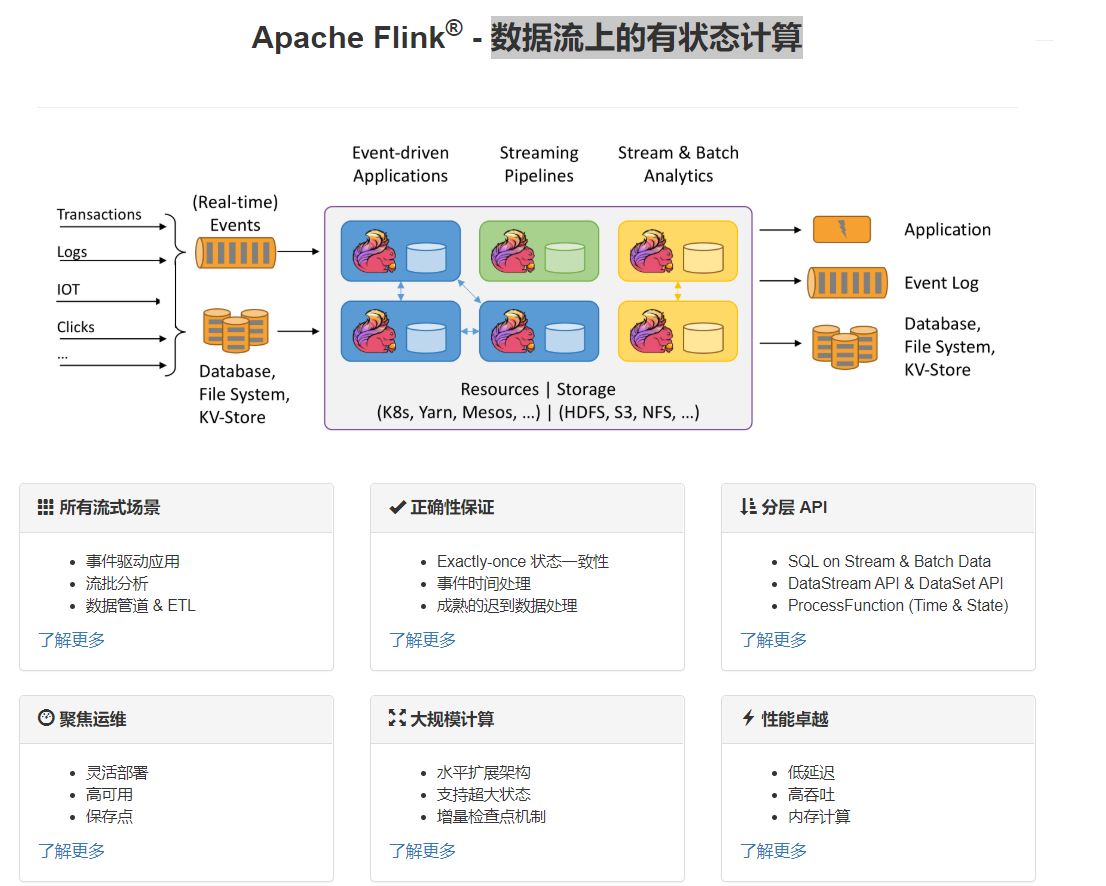
组件栈
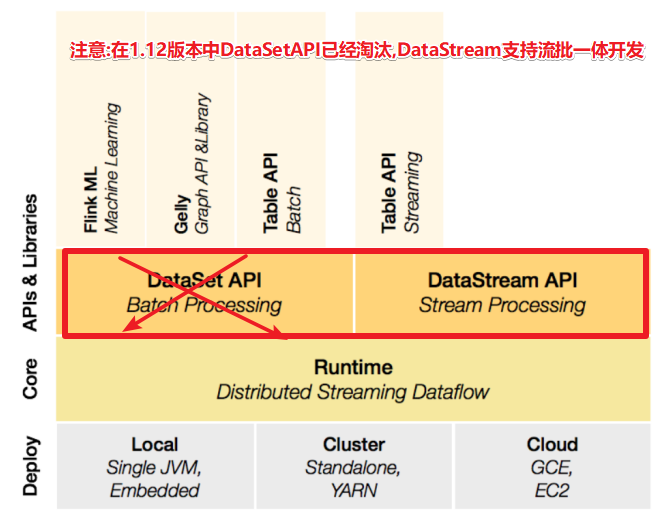
应用场景
所有的流式计算
Flink安装部署
local本地模式-了解
原理

操作
1.下载安装包
https://archive.apache.org/dist/flink/
2.上传flink-1.12.0-bin-scala_2.12.tgz到node1的指定目录
3.解压
tar -zxvf flink-1.12.0-bin-scala_2.12.tgz
4.如果出现权限问题,需要修改权限
chown -R root:root /export/server/flink-1.12.0
5.改名或创建软链接
mv flink-1.12.0 flink
ln -s /export/server/flink-1.12.0 /export/server/flink
测试
1.准备文件/root/words.txt
vim /root/words.txt
hello me you herhello me youhello mehello
2.启动Flink本地“集群”
/export/server/flink/bin/start-cluster.sh
3.使用jps可以查看到下面两个进程
- TaskManagerRunner
- StandaloneSessionClusterEntrypoint
4.访问Flink的Web UI
http://node1:8081/#/overview

slot在Flink里面可以认为是资源组,Flink是通过将任务分成子任务并且将这些子任务分配到slot来并行执行程序。
5.执行官方示例
/export/server/flink/bin/flink run /export/server/flink/examples/batch/WordCount.jar --input /root/words.txt --output /root/out6.停止Flink
/export/server/flink/bin/stop-cluster.sh
启动shell交互式窗口(目前所有Scala 2.12版本的安装包暂时都不支持 Scala Shell)
/export/server/flink/bin/start-scala-shell.sh local
执行如下命令
benv.readTextFile("/root/words.txt").flatMap(_.split(" ")).map((_,1)).groupBy(0).sum(1).print()退出shell
:quit
Standalone独立集群模式-了解
原理
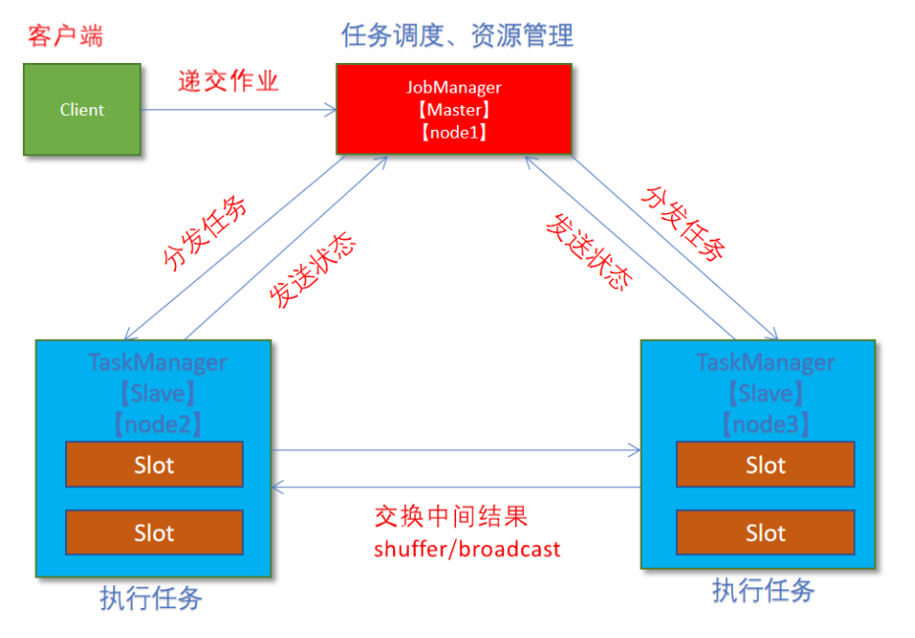
操作
1.集群规划:
- 服务器: node1(Master + Slave): JobManager + TaskManager
- 服务器: node2(Slave): TaskManager
- 服务器: node3(Slave): TaskManager
2.修改flink-conf.yaml
vim /export/server/flink/conf/flink-conf.yaml
jobmanager.rpc.address: node1taskmanager.numberOfTaskSlots: 2web.submit.enable: true#历史服务器jobmanager.archive.fs.dir: hdfs://node1:8020/flink/completed-jobs/historyserver.web.address: node1historyserver.web.port: 8082historyserver.archive.fs.dir: hdfs://node1:8020/flink/completed-jobs/
2.修改masters
vim /export/server/flink/conf/masters
node1:80813.修改slaves
vim /export/server/flink/conf/workers
node1node2node3
4.添加HADOOPCONFDIR环境变量
vim /etc/profile
export HADOOP_CONF_DIR=/export/server/hadoop/etc/hadoop5.分发
scp -r /export/server/flink node2:/export/server/flink
scp -r /export/server/flink node3:/export/server/flink
scp /etc/profile node2:/etc/profile
scp /etc/profile node3:/etc/profile
或
for i in {2..3}; do scp -r flink node$i:$PWD; done6.source
source /etc/profile
测试
1.启动集群,在node1上执行如下命令
/export/server/flink/bin/start-cluster.sh
或者单独启动
/export/server/flink/bin/jobmanager.sh ((start|start-foreground) cluster)|stop|stop-all
/export/server/flink/bin/taskmanager.sh start|start-foreground|stop|stop-all
2.启动历史服务器
/export/server/flink/bin/historyserver.sh start
3.访问Flink UI界面或使用jps查看
http://node1:8081/#/overview
http://node1:8082/#/overview
4.执行官方测试案例
/export/server/flink/bin/flink run /export/server/flink/examples/batch/WordCount.jar
5.停止Flink集群
/export/server/flink/bin/stop-cluster.sh
Standalone-HA高可用集群模式-了解
原理

操作
1.集群规划
- 服务器: node1(Master + Slave): JobManager + TaskManager
- 服务器: node2(Master + Slave): JobManager + TaskManager
- 服务器: node3(Slave): TaskManager
2.启动ZooKeeper
zkServer.sh status
zkServer.sh stop
zkServer.sh start
3.启动HDFS
/export/serves/hadoop/sbin/start-dfs.sh
4.停止Flink集群
/export/server/flink/bin/stop-cluster.sh
5.修改flink-conf.yaml
vim /export/server/flink/conf/flink-conf.yaml
增加如下内容
state.backend: filesystemstate.backend.fs.checkpointdir: hdfs://node1:8020/flink-checkpointshigh-availability: zookeeperhigh-availability.storageDir: hdfs://node1:8020/flink/ha/high-availability.zookeeper.quorum: node1:2181,node2:2181,node3:2181
6.修改masters
vim /export/server/flink/conf/masters
7.同步
scp -r /export/server/flink/conf/flink-conf.yaml node2:/export/server/flink/conf/scp -r /export/server/flink/conf/flink-conf.yaml node3:/export/server/flink/conf/scp -r /export/server/flink/conf/masters node2:/export/server/flink/conf/scp -r /export/server/flink/conf/masters node3:/export/server/flink/conf/
8.修改node2上的flink-conf.yaml
vim /export/server/flink/conf/flink-conf.yaml
jobmanager.rpc.address: node29.重新启动Flink集群,node1上执行
/export/server/flink/bin/stop-cluster.sh
/export/server/flink/bin/start-cluster.sh

10.使用jps命令查看
发现没有Flink相关进程被启动
11.查看日志
cat /export/server/flink/log/flink-root-standalonesession-0-node1.log
发现如下错误

因为在Flink1.8版本后,Flink官方提供的安装包里没有整合HDFS的jar
12.下载jar包并在Flink的lib目录下放入该jar包并分发使Flink能够支持对Hadoop的操作
下载地址
https://flink.apache.org/downloads.html
13.放入lib目录
cd /export/server/flink/lib

14.分发
for i in {2..3}; do scp -r flink-shaded-hadoop-2-uber-2.7.5-10.0.jar node$i:$PWD; done15.重新启动Flink集群,node1上执行
/export/server/flink/bin/stop-cluster.sh
/export/server/flink/bin/start-cluster.sh
16.使用jps命令查看,发现三台机器已经ok
测试
1.访问WebUI
http://node1:8081/#/job-manager/config
http://node2:8081/#/job-manager/config
2.执行wc
/export/server/flink/bin/flink run /export/server/flink/examples/batch/WordCount.jar
3.kill掉其中一个master
4.重新执行wc,还是可以正常执行
/export/server/flink/bin/flink run /export/server/flink/examples/batch/WordCount.jar
3.停止集群
/export/server/flink/bin/stop-cluster.sh
Flink-On-Yarn-开发使用
原理

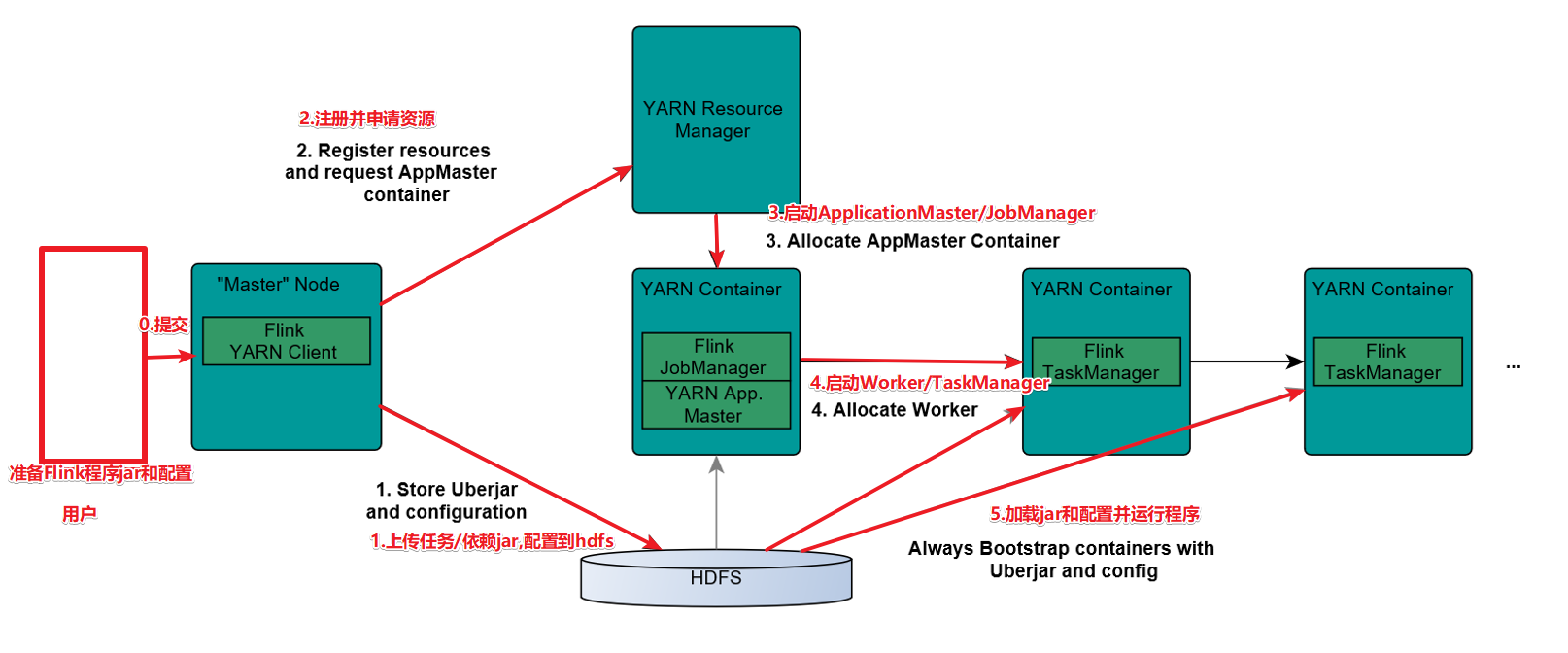
两种模式
Session会话模式

Job分离模式

操作
1.关闭yarn的内存检查
vim /export/server/hadoop/etc/hadoop/yarn-site.xml
<!-- 关闭yarn内存检查 --><property><name>yarn.nodemanager.pmem-check-enabled</name><value>false</value></property><property><name>yarn.nodemanager.vmem-check-enabled</name><value>false</value></property>
2.分发
scp -r /export/server/hadoop/etc/hadoop/yarn-site.xml node2:/export/server/hadoop/etc/hadoop/yarn-site.xmlscp -r /export/server/hadoop/etc/hadoop/yarn-site.xml node3:/export/server/hadoop/etc/hadoop/yarn-site.xml
3.重启yarn
/export/server/hadoop/sbin/stop-yarn.sh
/export/server/hadoop/sbin/start-yarn.sh
测试
Session会话模式
在Yarn上启动一个Flink集群,并重复使用该集群,后续提交的任务都是给该集群,资源会被一直占用,除非手动关闭该集群----适用于大量的小任务
1.在yarn上启动一个Flink集群/会话,node1上执行以下命令
/export/server/flink/bin/yarn-session.sh -n 2 -tm 800 -s 1 -d
说明:
申请2个CPU、1600M内存
# -n 表示申请2个容器,这里指的就是多少个taskmanager
# -tm 表示每个TaskManager的内存大小
# -s 表示每个TaskManager的slots数量
# -d 表示以后台程序方式运行
注意:
该警告不用管
WARN org.apache.hadoop.hdfs.DFSClient - Caught exception
java.lang.InterruptedException
2.查看UI界面
http://node1:8088/cluster

3.使用flink run提交任务:
/export/server/flink/bin/flink run /export/server/flink/examples/batch/WordCount.jar
运行完之后可以继续运行其他的小任务
/export/server/flink/bin/flink run /export/server/flink/examples/batch/WordCount.jar
4.通过上方的ApplicationMaster可以进入Flink的管理界面


==5.关闭yarn-session:==
yarn application -kill application16095080879770005

Job分离模式--用的更多
针对每个Flink任务在Yarn上启动一个独立的Flink集群并运行,结束后自动关闭并释放资源,----适用于大任务
1.直接提交job
/export/server/flink/bin/flink run -m yarn-cluster -yjm 1024 -ytm 1024 /export/server/flink/examples/batch/WordCount.jar
# -m jobmanager的地址
# -yjm 1024 指定jobmanager的内存信息
# -ytm 1024 指定taskmanager的内存信息
2.查看UI界面
http://node1:8088/cluster


参数说明
/export/server/flink/bin/flink --helpSLF4J: Class path contains multiple SLF4J bindings.SLF4J: Found binding in [jar:file:/export/server/flink/lib/log4j-slf4j-impl-2.12.1.jar!/org/slf4j/impl/StaticLoggerBinder.class]SLF4J: Found binding in [jar:file:/export/server/hadoop-2.7.5/share/hadoop/common/lib/slf4j-log4j12-1.7.10.jar!/org/slf4j/impl/StaticLoggerBinder.class]SLF4J: See http://www.slf4j.org/codes.html#multiple_bindings for an explanation.SLF4J: Actual binding is of type [org.apache.logging.slf4j.Log4jLoggerFactory]./flink <ACTION> [OPTIONS] [ARGUMENTS]The following actions are available:Action "run" compiles and runs a program.Syntax: run [OPTIONS] <jar-file> <arguments>"run" action options:-c,--class <classname> Class with the program entry point("main()" method). Only needed if theJAR file does not specify the class inits manifest.-C,--classpath <url> Adds a URL to each user codeclassloader on all nodes in thecluster. The paths must specify aprotocol (e.g. file://) and beaccessible on all nodes (e.g. by meansof a NFS share). You can use thisoption multiple times for specifyingmore than one URL. The protocol mustbe supported by the {@linkjava.net.URLClassLoader}.-d,--detached If present, runs the job in detachedmode-n,--allowNonRestoredState Allow to skip savepoint state thatcannot be restored. You need to allowthis if you removed an operator fromyour program that was part of theprogram when the savepoint wastriggered.-p,--parallelism <parallelism> The parallelism with which to run theprogram. Optional flag to override thedefault value specified in theconfiguration.-py,--python <pythonFile> Python script with the program entrypoint. The dependent resources can beconfigured with the `--pyFiles`option.-pyarch,--pyArchives <arg> Add python archive files for job. Thearchive files will be extracted to theworking directory of python UDFworker. Currently only zip-format issupported. For each archive file, atarget directory be specified. If thetarget directory name is specified,the archive file will be extracted toa name can directory with thespecified name. Otherwise, the archivefile will be extracted to a directorywith the same name of the archivefile. The files uploaded via thisoption are accessible via relativepath. '#' could be used as theseparator of the archive file path andthe target directory name. Comma (',')could be used as the separator tospecify multiple archive files. Thisoption can be used to upload thevirtual environment, the data filesused in Python UDF (e.g.: --pyArchivesfile:///tmp/py37.zip,file:///tmp/data.zip#data --pyExecutablepy37.zip/py37/bin/python). The datafiles could be accessed in Python UDF,e.g.: f = open('data/data.txt', 'r').-pyexec,--pyExecutable <arg> Specify the path of the pythoninterpreter used to execute the pythonUDF worker (e.g.: --pyExecutable/usr/local/bin/python3). The pythonUDF worker depends on Python 3.5+,Apache Beam (version == 2.23.0), Pip(version >= 7.1.0) and SetupTools(version >= 37.0.0). Please ensurethat the specified environment meetsthe above requirements.-pyfs,--pyFiles <pythonFiles> Attach custom python files for job.These files will be added to thePYTHONPATH of both the local clientand the remote python UDF worker. Thestandard python resource file suffixessuch as .py/.egg/.zip or directory areall supported. Comma (',') could beused as the separator to specifymultiple files (e.g.: --pyFilesfile:///tmp/myresource.zip,hdfs:///$namenode_address/myresource2.zip).-pym,--pyModule <pythonModule> Python module with the program entrypoint. This option must be used inconjunction with `--pyFiles`.-pyreq,--pyRequirements <arg> Specify a requirements.txt file whichdefines the third-party dependencies.These dependencies will be installedand added to the PYTHONPATH of thepython UDF worker. A directory whichcontains the installation packages ofthese dependencies could be specifiedoptionally. Use '#' as the separatorif the optional parameter exists(e.g.: --pyRequirementsfile:///tmp/requirements.txt#file:///tmp/cached_dir).-s,--fromSavepoint <savepointPath> Path to a savepoint to restore the jobfrom (for examplehdfs:///flink/savepoint-1537).-sae,--shutdownOnAttachedExit If the job is submitted in attachedmode, perform a best-effort clustershutdown when the CLI is terminatedabruptly, e.g., in response to a userinterrupt, such as typing Ctrl + C.Options for Generic CLI mode:-D <property=value> Allows specifying multiple generic configurationoptions. The available options can be found athttps://ci.apache.org/projects/flink/flink-docs-stable/ops/config.html-e,--executor <arg> DEPRECATED: Please use the -t option instead which isalso available with the "Application Mode".The name of the executor to be used for executing thegiven job, which is equivalent to the"execution.target" config option. The currentlyavailable executors are: "remote", "local","kubernetes-session", "yarn-per-job", "yarn-session".-t,--target <arg> The deployment target for the given application,which is equivalent to the "execution.target" configoption. For the "run" action the currently availabletargets are: "remote", "local", "kubernetes-session","yarn-per-job", "yarn-session". For the"run-application" action the currently availabletargets are: "kubernetes-application","yarn-application".Options for yarn-cluster mode:-d,--detached If present, runs the job in detachedmode-m,--jobmanager <arg> Set to yarn-cluster to use YARNexecution mode.-yat,--yarnapplicationType <arg> Set a custom application type for theapplication on YARN-yD <property=value> use value for given property-yd,--yarndetached If present, runs the job in detachedmode (deprecated; use non-YARNspecific option instead)-yh,--yarnhelp Help for the Yarn session CLI.-yid,--yarnapplicationId <arg> Attach to running YARN session-yj,--yarnjar <arg> Path to Flink jar file-yjm,--yarnjobManagerMemory <arg> Memory for JobManager Container withoptional unit (default: MB)-ynl,--yarnnodeLabel <arg> Specify YARN node label for the YARNapplication-ynm,--yarnname <arg> Set a custom name for the applicationon YARN-yq,--yarnquery Display available YARN resources(memory, cores)-yqu,--yarnqueue <arg> Specify YARN queue.-ys,--yarnslots <arg> Number of slots per TaskManager-yt,--yarnship <arg> Ship files in the specified directory(t for transfer)-ytm,--yarntaskManagerMemory <arg> Memory per TaskManager Container withoptional unit (default: MB)-yz,--yarnzookeeperNamespace <arg> Namespace to create the Zookeepersub-paths for high availability mode-z,--zookeeperNamespace <arg> Namespace to create the Zookeepersub-paths for high availability modeOptions for default mode:-D <property=value> Allows specifying multiple genericconfiguration options. The availableoptions can be found athttps://ci.apache.org/projects/flink/flink-docs-stable/ops/config.html-m,--jobmanager <arg> Address of the JobManager to which toconnect. Use this flag to connect to adifferent JobManager than the one specifiedin the configuration. Attention: Thisoption is respected only if thehigh-availability configuration is NONE.-z,--zookeeperNamespace <arg> Namespace to create the Zookeeper sub-pathsfor high availability modeAction "run-application" runs an application in Application Mode.Syntax: run-application [OPTIONS] <jar-file> <arguments>Options for Generic CLI mode:-D <property=value> Allows specifying multiple generic configurationoptions. The available options can be found athttps://ci.apache.org/projects/flink/flink-docs-stable/ops/config.html-e,--executor <arg> DEPRECATED: Please use the -t option instead which isalso available with the "Application Mode".The name of the executor to be used for executing thegiven job, which is equivalent to the"execution.target" config option. The currentlyavailable executors are: "remote", "local","kubernetes-session", "yarn-per-job", "yarn-session".-t,--target <arg> The deployment target for the given application,which is equivalent to the "execution.target" configoption. For the "run" action the currently availabletargets are: "remote", "local", "kubernetes-session","yarn-per-job", "yarn-session". For the"run-application" action the currently availabletargets are: "kubernetes-application","yarn-application".Action "info" shows the optimized execution plan of the program (JSON).Syntax: info [OPTIONS] <jar-file> <arguments>"info" action options:-c,--class <classname> Class with the program entry point("main()" method). Only needed if the JARfile does not specify the class in itsmanifest.-p,--parallelism <parallelism> The parallelism with which to run theprogram. Optional flag to override thedefault value specified in theconfiguration.Action "list" lists running and scheduled programs.Syntax: list [OPTIONS]"list" action options:-a,--all Show all programs and their JobIDs-r,--running Show only running programs and their JobIDs-s,--scheduled Show only scheduled programs and their JobIDsOptions for Generic CLI mode:-D <property=value> Allows specifying multiple generic configurationoptions. The available options can be found athttps://ci.apache.org/projects/flink/flink-docs-stable/ops/config.html-e,--executor <arg> DEPRECATED: Please use the -t option instead which isalso available with the "Application Mode".The name of the executor to be used for executing thegiven job, which is equivalent to the"execution.target" config option. The currentlyavailable executors are: "remote", "local","kubernetes-session", "yarn-per-job", "yarn-session".-t,--target <arg> The deployment target for the given application,which is equivalent to the "execution.target" configoption. For the "run" action the currently availabletargets are: "remote", "local", "kubernetes-session","yarn-per-job", "yarn-session". For the"run-application" action the currently availabletargets are: "kubernetes-application","yarn-application".Options for yarn-cluster mode:-m,--jobmanager <arg> Set to yarn-cluster to use YARN executionmode.-yid,--yarnapplicationId <arg> Attach to running YARN session-z,--zookeeperNamespace <arg> Namespace to create the Zookeepersub-paths for high availability modeOptions for default mode:-D <property=value> Allows specifying multiple genericconfiguration options. The availableoptions can be found athttps://ci.apache.org/projects/flink/flink-docs-stable/ops/config.html-m,--jobmanager <arg> Address of the JobManager to which toconnect. Use this flag to connect to adifferent JobManager than the one specifiedin the configuration. Attention: Thisoption is respected only if thehigh-availability configuration is NONE.-z,--zookeeperNamespace <arg> Namespace to create the Zookeeper sub-pathsfor high availability modeAction "stop" stops a running program with a savepoint (streaming jobs only).Syntax: stop [OPTIONS] <Job ID>"stop" action options:-d,--drain Send MAX_WATERMARK before taking thesavepoint and stopping the pipelne.-p,--savepointPath <savepointPath> Path to the savepoint (for examplehdfs:///flink/savepoint-1537). If nodirectory is specified, the configureddefault will be used("state.savepoints.dir").Options for Generic CLI mode:-D <property=value> Allows specifying multiple generic configurationoptions. The available options can be found athttps://ci.apache.org/projects/flink/flink-docs-stable/ops/config.html-e,--executor <arg> DEPRECATED: Please use the -t option instead which isalso available with the "Application Mode".The name of the executor to be used for executing thegiven job, which is equivalent to the"execution.target" config option. The currentlyavailable executors are: "remote", "local","kubernetes-session", "yarn-per-job", "yarn-session".-t,--target <arg> The deployment target for the given application,which is equivalent to the "execution.target" configoption. For the "run" action the currently availabletargets are: "remote", "local", "kubernetes-session","yarn-per-job", "yarn-session". For the"run-application" action the currently availabletargets are: "kubernetes-application","yarn-application".Options for yarn-cluster mode:-m,--jobmanager <arg> Set to yarn-cluster to use YARN executionmode.-yid,--yarnapplicationId <arg> Attach to running YARN session-z,--zookeeperNamespace <arg> Namespace to create the Zookeepersub-paths for high availability modeOptions for default mode:-D <property=value> Allows specifying multiple genericconfiguration options. The availableoptions can be found athttps://ci.apache.org/projects/flink/flink-docs-stable/ops/config.html-m,--jobmanager <arg> Address of the JobManager to which toconnect. Use this flag to connect to adifferent JobManager than the one specifiedin the configuration. Attention: Thisoption is respected only if thehigh-availability configuration is NONE.-z,--zookeeperNamespace <arg> Namespace to create the Zookeeper sub-pathsfor high availability modeAction "cancel" cancels a running program.Syntax: cancel [OPTIONS] <Job ID>"cancel" action options:-s,--withSavepoint <targetDirectory> **DEPRECATION WARNING**: Cancellinga job with savepoint is deprecated.Use "stop" instead.Trigger savepoint and cancel job.The target directory is optional. Ifno directory is specified, theconfigured default directory(state.savepoints.dir) is used.Options for Generic CLI mode:-D <property=value> Allows specifying multiple generic configurationoptions. The available options can be found athttps://ci.apache.org/projects/flink/flink-docs-stable/ops/config.html-e,--executor <arg> DEPRECATED: Please use the -t option instead which isalso available with the "Application Mode".The name of the executor to be used for executing thegiven job, which is equivalent to the"execution.target" config option. The currentlyavailable executors are: "remote", "local","kubernetes-session", "yarn-per-job", "yarn-session".-t,--target <arg> The deployment target for the given application,which is equivalent to the "execution.target" configoption. For the "run" action the currently availabletargets are: "remote", "local", "kubernetes-session","yarn-per-job", "yarn-session". For the"run-application" action the currently availabletargets are: "kubernetes-application","yarn-application".Options for yarn-cluster mode:-m,--jobmanager <arg> Set to yarn-cluster to use YARN executionmode.-yid,--yarnapplicationId <arg> Attach to running YARN session-z,--zookeeperNamespace <arg> Namespace to create the Zookeepersub-paths for high availability modeOptions for default mode:-D <property=value> Allows specifying multiple genericconfiguration options. The availableoptions can be found athttps://ci.apache.org/projects/flink/flink-docs-stable/ops/config.html-m,--jobmanager <arg> Address of the JobManager to which toconnect. Use this flag to connect to adifferent JobManager than the one specifiedin the configuration. Attention: Thisoption is respected only if thehigh-availability configuration is NONE.-z,--zookeeperNamespace <arg> Namespace to create the Zookeeper sub-pathsfor high availability modeAction "savepoint" triggers savepoints for a running job or disposes existing ones.Syntax: savepoint [OPTIONS] <Job ID> [<target directory>]"savepoint" action options:-d,--dispose <arg> Path of savepoint to dispose.-j,--jarfile <jarfile> Flink program JAR file.Options for Generic CLI mode:-D <property=value> Allows specifying multiple generic configurationoptions. The available options can be found athttps://ci.apache.org/projects/flink/flink-docs-stable/ops/config.html-e,--executor <arg> DEPRECATED: Please use the -t option instead which isalso available with the "Application Mode".The name of the executor to be used for executing thegiven job, which is equivalent to the"execution.target" config option. The currentlyavailable executors are: "remote", "local","kubernetes-session", "yarn-per-job", "yarn-session".-t,--target <arg> The deployment target for the given application,which is equivalent to the "execution.target" configoption. For the "run" action the currently availabletargets are: "remote", "local", "kubernetes-session","yarn-per-job", "yarn-session". For the"run-application" action the currently availabletargets are: "kubernetes-application","yarn-application".Options for yarn-cluster mode:-m,--jobmanager <arg> Set to yarn-cluster to use YARN executionmode.-yid,--yarnapplicationId <arg> Attach to running YARN session-z,--zookeeperNamespace <arg> Namespace to create the Zookeepersub-paths for high availability modeOptions for default mode:-D <property=value> Allows specifying multiple genericconfiguration options. The availableoptions can be found athttps://ci.apache.org/projects/flink/flink-docs-stable/ops/config.html-m,--jobmanager <arg> Address of the JobManager to which toconnect. Use this flag to connect to adifferent JobManager than the one specifiedin the configuration. Attention: Thisoption is respected only if thehigh-availability configuration is NONE.-z,--zookeeperNamespace <arg> Namespace to create the Zookeeper sub-pathsfor high availability mode
Flink入门案例
前置说明
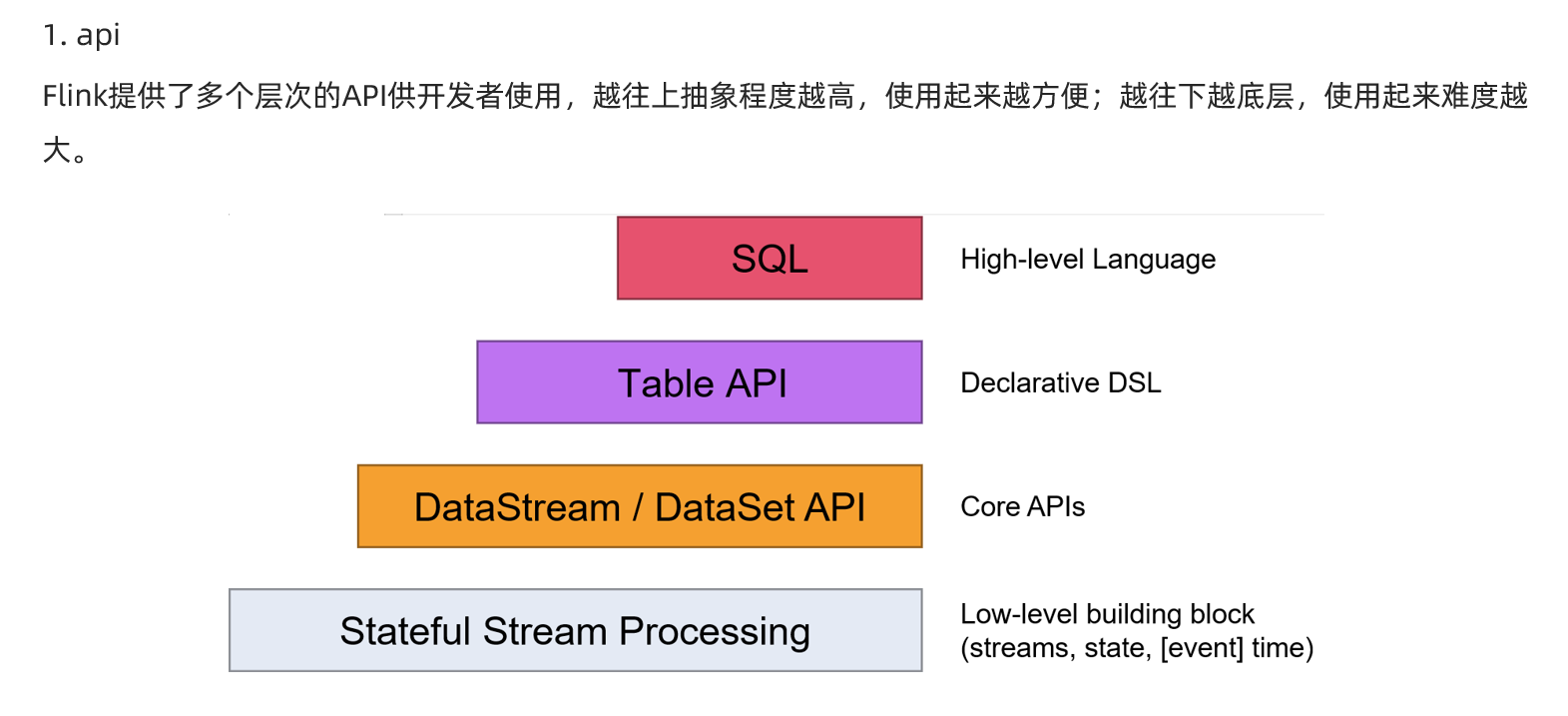
注意:入门案例使用DataSet后续就不再使用了,而是使用流批一体的DataStream


https://ci.apache.org/projects/flink/flink-docs-release-1.12/dev/batch/

准备环境

POM
<?xml version="1.0" encoding="UTF-8"?><project xmlns="http://maven.apache.org/POM/4.0.0"xmlns:xsi="http://www.w3.org/2001/XMLSchema-instance"xsi:schemaLocation="http://maven.apache.org/POM/4.0.0 http://maven.apache.org/xsd/maven-4.0.0.xsd"><modelVersion>4.0.0</modelVersion><groupId>XX.XXXX</groupId><artifactId>flink_XXXXX</artifactId><version>1.0-SNAPSHOT</version><!-- 指定仓库位置,依次为aliyun、apache和cloudera仓库 --><repositories><repository><id>aliyun</id><url>http://maven.aliyun.com/nexus/content/groups/public/</url></repository><repository><id>apache</id><url>https://repository.apache.org/content/repositories/snapshots/</url></repository><repository><id>cloudera</id><url>https://repository.cloudera.com/artifactory/cloudera-repos/</url></repository></repositories><properties><encoding>UTF-8</encoding><project.build.sourceEncoding>UTF-8</project.build.sourceEncoding><maven.compiler.source>1.8</maven.compiler.source><maven.compiler.target>1.8</maven.compiler.target><java.version>1.8</java.version><scala.version>2.12</scala.version><flink.version>1.12.0</flink.version></properties><dependencies><dependency><groupId>org.apache.flink</groupId><artifactId>flink-clients_2.12</artifactId><version>${flink.version}</version></dependency><dependency><groupId>org.apache.flink</groupId><artifactId>flink-scala_2.12</artifactId><version>${flink.version}</version></dependency><dependency><groupId>org.apache.flink</groupId><artifactId>flink-java</artifactId><version>${flink.version}</version></dependency><dependency><groupId>org.apache.flink</groupId><artifactId>flink-streaming-scala_2.12</artifactId><version>${flink.version}</version></dependency><dependency><groupId>org.apache.flink</groupId><artifactId>flink-streaming-java_2.12</artifactId><version>${flink.version}</version></dependency><dependency><groupId>org.apache.flink</groupId><artifactId>flink-table-api-scala-bridge_2.12</artifactId><version>${flink.version}</version></dependency><dependency><groupId>org.apache.flink</groupId><artifactId>flink-table-api-java-bridge_2.12</artifactId><version>${flink.version}</version></dependency><!-- flink执行计划,这是1.9版本之前的--><dependency><groupId>org.apache.flink</groupId><artifactId>flink-table-planner_2.12</artifactId><version>${flink.version}</version></dependency><!-- blink执行计划,1.11+默认的--><dependency><groupId>org.apache.flink</groupId><artifactId>flink-table-planner-blink_2.12</artifactId><version>${flink.version}</version></dependency><dependency><groupId>org.apache.flink</groupId><artifactId>flink-table-common</artifactId><version>${flink.version}</version></dependency><!--<dependency><groupId>org.apache.flink</groupId><artifactId>flink-cep_2.12</artifactId><version>${flink.version}</version></dependency>--><!-- flink连接器--><dependency><groupId>org.apache.flink</groupId><artifactId>flink-connector-kafka_2.12</artifactId><version>${flink.version}</version></dependency><dependency><groupId>org.apache.flink</groupId><artifactId>flink-sql-connector-kafka_2.12</artifactId><version>${flink.version}</version></dependency><dependency><groupId>org.apache.flink</groupId><artifactId>flink-connector-jdbc_2.12</artifactId><version>${flink.version}</version></dependency><dependency><groupId>org.apache.flink</groupId><artifactId>flink-csv</artifactId><version>${flink.version}</version></dependency><dependency><groupId>org.apache.flink</groupId><artifactId>flink-json</artifactId><version>${flink.version}</version></dependency><!-- <dependency><groupId>org.apache.flink</groupId><artifactId>flink-connector-filesystem_2.12</artifactId><version>${flink.version}</version></dependency>--><!--<dependency><groupId>org.apache.flink</groupId><artifactId>flink-jdbc_2.12</artifactId><version>${flink.version}</version></dependency>--><!--<dependency><groupId>org.apache.flink</groupId><artifactId>flink-parquet_2.12</artifactId><version>${flink.version}</version></dependency>--><!--<dependency><groupId>org.apache.avro</groupId><artifactId>avro</artifactId><version>1.9.2</version></dependency><dependency><groupId>org.apache.parquet</groupId><artifactId>parquet-avro</artifactId><version>1.10.0</version></dependency>--><dependency><groupId>org.apache.bahir</groupId><artifactId>flink-connector-redis_2.11</artifactId><version>1.0</version><exclusions><exclusion><artifactId>flink-streaming-java_2.11</artifactId><groupId>org.apache.flink</groupId></exclusion><exclusion><artifactId>flink-runtime_2.11</artifactId><groupId>org.apache.flink</groupId></exclusion><exclusion><artifactId>flink-core</artifactId><groupId>org.apache.flink</groupId></exclusion><exclusion><artifactId>flink-java</artifactId><groupId>org.apache.flink</groupId></exclusion></exclusions></dependency><dependency><groupId>org.apache.flink</groupId><artifactId>flink-connector-hive_2.12</artifactId><version>${flink.version}</version></dependency><dependency><groupId>org.apache.hive</groupId><artifactId>hive-metastore</artifactId><version>2.1.0</version></dependency><dependency><groupId>org.apache.hive</groupId><artifactId>hive-exec</artifactId><version>2.1.0</version></dependency><dependency><groupId>org.apache.flink</groupId><artifactId>flink-shaded-hadoop-2-uber</artifactId><version>2.7.5-10.0</version></dependency><dependency><groupId>org.apache.hbase</groupId><artifactId>hbase-client</artifactId><version>2.1.0</version></dependency><dependency><groupId>mysql</groupId><artifactId>mysql-connector-java</artifactId><version>5.1.38</version><!--<version>8.0.20</version>--></dependency><!-- 高性能异步组件:Vertx--><dependency><groupId>io.vertx</groupId><artifactId>vertx-core</artifactId><version>3.9.0</version></dependency><dependency><groupId>io.vertx</groupId><artifactId>vertx-jdbc-client</artifactId><version>3.9.0</version></dependency><dependency><groupId>io.vertx</groupId><artifactId>vertx-redis-client</artifactId><version>3.9.0</version></dependency><!-- 日志 --><dependency><groupId>org.slf4j</groupId><artifactId>slf4j-log4j12</artifactId><version>1.7.7</version><scope>runtime</scope></dependency><dependency><groupId>log4j</groupId><artifactId>log4j</artifactId><version>1.2.17</version><scope>runtime</scope></dependency><dependency><groupId>com.alibaba</groupId><artifactId>fastjson</artifactId><version>1.2.44</version></dependency><dependency><groupId>org.projectlombok</groupId><artifactId>lombok</artifactId><version>1.18.2</version><scope>provided</scope></dependency><!-- 参考:https://blog.csdn.net/f641385712/article/details/84109098--><!--<dependency><groupId>org.apache.commons</groupId><artifactId>commons-collections4</artifactId><version>4.4</version></dependency>--><!--<dependency><groupId>org.apache.thrift</groupId><artifactId>libfb303</artifactId><version>0.9.3</version><type>pom</type><scope>provided</scope></dependency>--><!--<dependency><groupId>com.google.guava</groupId><artifactId>guava</artifactId><version>28.2-jre</version></dependency>--></dependencies><build><sourceDirectory>src/main/java</sourceDirectory><plugins><!-- 编译插件 --><plugin><groupId>org.apache.maven.plugins</groupId><artifactId>maven-compiler-plugin</artifactId><version>3.5.1</version><configuration><source>1.8</source><target>1.8</target><!--<encoding>${project.build.sourceEncoding}</encoding>--></configuration></plugin><plugin><groupId>org.apache.maven.plugins</groupId><artifactId>maven-surefire-plugin</artifactId><version>2.18.1</version><configuration><useFile>false</useFile><disableXmlReport>true</disableXmlReport><includes><include>**/*Test.*</include><include>**/*Suite.*</include></includes></configuration></plugin><!-- 打包插件(会包含所有依赖) --><plugin><groupId>org.apache.maven.plugins</groupId><artifactId>maven-shade-plugin</artifactId><version>2.3</version><executions><execution><phase>package</phase><goals><goal>shade</goal></goals><configuration><filters><filter><artifact>*:*</artifact><excludes><!--zip -d learn_spark.jar META-INF/*.RSA META-INF/*.DSA META-INF/*.SF --><exclude>META-INF/*.SF</exclude><exclude>META-INF/*.DSA</exclude><exclude>META-INF/*.RSA</exclude></excludes></filter></filters><transformers><transformer implementation="org.apache.maven.plugins.shade.resource.ManifestResourceTransformer"><!-- 设置jar包的入口类(可选) --><mainClass></mainClass></transformer></transformers></configuration></execution></executions></plugin></plugins></build></project>


代码实现-DataSet-了解
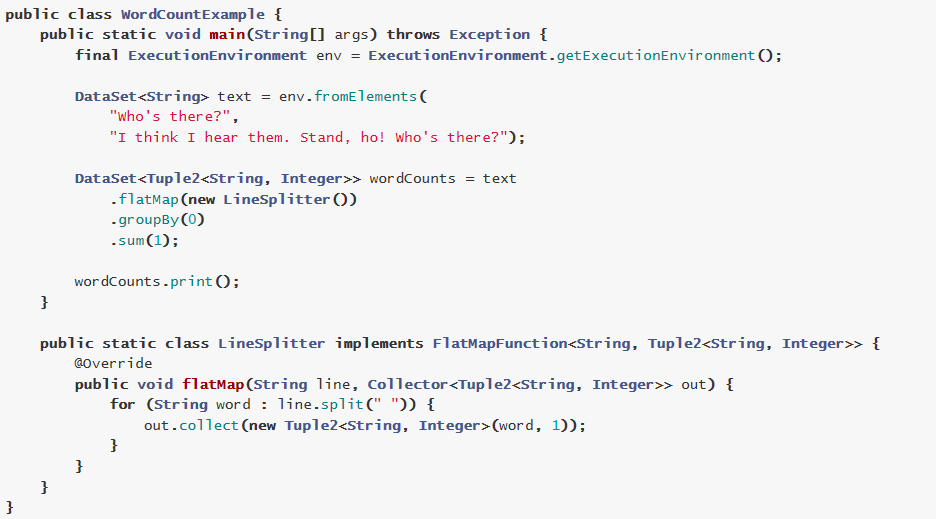
import org.apache.flink.api.common.functions.FlatMapFunction;import org.apache.flink.api.common.functions.MapFunction;import org.apache.flink.api.java.DataSet;import org.apache.flink.api.java.ExecutionEnvironment;import org.apache.flink.api.java.operators.AggregateOperator;import org.apache.flink.api.java.operators.UnsortedGrouping;import org.apache.flink.api.java.tuple.Tuple2;import org.apache.flink.util.Collector;/*** Author ZuoYan* Desc 演示Flink-DataSet-API-实现WordCount*/public class WordCount {public static void main(String[] args) throws Exception {//TODO 0.envExecutionEnvironment env = ExecutionEnvironment.getExecutionEnvironment();//TODO 1.sourceDataSet<String> lines = env.fromElements("itcast hadoop spark", "itcast hadoop spark", "itcast hadoop", "itcast");//TODO 2.transformation//切割/*@FunctionalInterfacepublic interface FlatMapFunction<T, O> extends Function, Serializable {void flatMap(T value, Collector<O> out) throws Exception;}*/DataSet<String> words = lines.flatMap(new FlatMapFunction<String, String>() {@Overridepublic void flatMap(String value, Collector<String> out) throws Exception {//value表示每一行数据String[] arr = value.split(" ");for (String word : arr) {out.collect(word);}}});//记为1/*@FunctionalInterfacepublic interface MapFunction<T, O> extends Function, Serializable {O map(T value) throws Exception;}*/DataSet<Tuple2<String, Integer>> wordAndOne = words.map(new MapFunction<String, Tuple2<String, Integer>>() {@Overridepublic Tuple2<String, Integer> map(String value) throws Exception {//value就是每一个单词return Tuple2.of(value, 1);}});//分组UnsortedGrouping<Tuple2<String, Integer>> grouped = wordAndOne.groupBy(0);//聚合AggregateOperator<Tuple2<String, Integer>> result = grouped.sum(1);//TODO 3.sinkresult.print();}}
代码实现-DataStream-匿名内部类-处理批

import org.apache.flink.api.common.functions.FlatMapFunction;import org.apache.flink.api.common.functions.MapFunction;import org.apache.flink.api.java.tuple.Tuple2;import org.apache.flink.streaming.api.datastream.DataStream;import org.apache.flink.streaming.api.datastream.KeyedStream;import org.apache.flink.streaming.api.datastream.SingleOutputStreamOperator;import org.apache.flink.streaming.api.environment.StreamExecutionEnvironment;import org.apache.flink.util.Collector;/*** Author ZuoYan* Desc 演示Flink-DataStream-API-实现WordCount* 注意:在Flink1.12中DataStream既支持流处理也支持批处理,如何区分?*/public class WordCount2 {public static void main(String[] args) throws Exception {//TODO 0.env//ExecutionEnvironment env = ExecutionEnvironment.getExecutionEnvironment();StreamExecutionEnvironment env = StreamExecutionEnvironment.getExecutionEnvironment();//env.setRuntimeMode(RuntimeExecutionMode.BATCH);//注意:使用DataStream实现批处理//env.setRuntimeMode(RuntimeExecutionMode.STREAMING);//注意:使用DataStream实现流处理//env.setRuntimeMode(RuntimeExecutionMode.AUTOMATIC);//注意:使用DataStream根据数据源自动选择使用流还是批//TODO 1.source//DataSet<String> lines = env.fromElements("itcast hadoop spark", "itcast hadoop spark", "itcast hadoop", "itcast");DataStream<String> lines = env.fromElements("itcast hadoop spark", "itcast hadoop spark", "itcast hadoop", "itcast");//TODO 2.transformation//切割/*@FunctionalInterfacepublic interface FlatMapFunction<T, O> extends Function, Serializable {void flatMap(T value, Collector<O> out) throws Exception;}*/DataStream<String> words = lines.flatMap(new FlatMapFunction<String, String>() {@Overridepublic void flatMap(String value, Collector<String> out) throws Exception {//value就是每一行数据String[] arr = value.split(" ");for (String word : arr) {out.collect(word);}}});//记为1/*@FunctionalInterfacepublic interface MapFunction<T, O> extends Function, Serializable {O map(T value) throws Exception;}*/DataStream<Tuple2<String, Integer>> wordAndOne = words.map(new MapFunction<String, Tuple2<String, Integer>>() {@Overridepublic Tuple2<String, Integer> map(String value) throws Exception {//value就是一个个单词return Tuple2.of(value, 1);}});//分组:注意DataSet中分组是groupBy,DataStream分组是keyBy//wordAndOne.keyBy(0);/*@FunctionalInterfacepublic interface KeySelector<IN, KEY> extends Function, Serializable {KEY getKey(IN value) throws Exception;}*/KeyedStream<Tuple2<String, Integer>, String> grouped = wordAndOne.keyBy(t -> t.f0);//聚合SingleOutputStreamOperator<Tuple2<String, Integer>> result = grouped.sum(1);//TODO 3.sinkresult.print();//TODO 4.execute/启动并等待程序结束env.execute();}}
代码实现-DataStream-匿名内部类-处理流
import org.apache.flink.api.common.RuntimeExecutionMode;import org.apache.flink.api.common.functions.FlatMapFunction;import org.apache.flink.api.common.functions.MapFunction;import org.apache.flink.api.java.tuple.Tuple2;import org.apache.flink.streaming.api.datastream.DataStream;import org.apache.flink.streaming.api.datastream.KeyedStream;import org.apache.flink.streaming.api.datastream.SingleOutputStreamOperator;import org.apache.flink.streaming.api.environment.StreamExecutionEnvironment;import org.apache.flink.util.Collector;/*** Author ZuoYan* Desc 演示Flink-DataStream-API-实现WordCount* 注意:在Flink1.12中DataStream既支持流处理也支持批处理,如何区分?*/public class WordCount3 {public static void main(String[] args) throws Exception {//TODO 0.env//ExecutionEnvironment env = ExecutionEnvironment.getExecutionEnvironment();StreamExecutionEnvironment env = StreamExecutionEnvironment.getExecutionEnvironment();//env.setRuntimeMode(RuntimeExecutionMode.BATCH);//注意:使用DataStream实现批处理//env.setRuntimeMode(RuntimeExecutionMode.STREAMING);//注意:使用DataStream实现流处理env.setRuntimeMode(RuntimeExecutionMode.AUTOMATIC);//注意:使用DataStream根据数据源自动选择使用流还是批//TODO 1.source//DataSet<String> lines = env.fromElements("itcast hadoop spark", "itcast hadoop spark", "itcast hadoop", "itcast");//DataStream<String> lines = env.fromElements("itcast hadoop spark", "itcast hadoop spark", "itcast hadoop", "itcast");DataStream<String> lines = env.socketTextStream("node1", 9999);//TODO 2.transformation//切割/*@FunctionalInterfacepublic interface FlatMapFunction<T, O> extends Function, Serializable {void flatMap(T value, Collector<O> out) throws Exception;}*/DataStream<String> words = lines.flatMap(new FlatMapFunction<String, String>() {@Overridepublic void flatMap(String value, Collector<String> out) throws Exception {//value就是每一行数据String[] arr = value.split(" ");for (String word : arr) {out.collect(word);}}});//记为1/*@FunctionalInterfacepublic interface MapFunction<T, O> extends Function, Serializable {O map(T value) throws Exception;}*/DataStream<Tuple2<String, Integer>> wordAndOne = words.map(new MapFunction<String, Tuple2<String, Integer>>() {@Overridepublic Tuple2<String, Integer> map(String value) throws Exception {//value就是一个个单词return Tuple2.of(value, 1);}});//分组:注意DataSet中分组是groupBy,DataStream分组是keyBy//wordAndOne.keyBy(0);/*@FunctionalInterfacepublic interface KeySelector<IN, KEY> extends Function, Serializable {KEY getKey(IN value) throws Exception;}*/KeyedStream<Tuple2<String, Integer>, String> grouped = wordAndOne.keyBy(t -> t.f0);//聚合SingleOutputStreamOperator<Tuple2<String, Integer>> result = grouped.sum(1);//TODO 3.sinkresult.print();//TODO 4.execute/启动并等待程序结束env.execute();}}
代码实现-DataStream-Lambda
import org.apache.flink.api.common.RuntimeExecutionMode;import org.apache.flink.api.common.typeinfo.Types;import org.apache.flink.api.java.tuple.Tuple2;import org.apache.flink.streaming.api.datastream.DataStream;import org.apache.flink.streaming.api.datastream.KeyedStream;import org.apache.flink.streaming.api.datastream.SingleOutputStreamOperator;import org.apache.flink.streaming.api.environment.StreamExecutionEnvironment;import org.apache.flink.util.Collector;import java.util.Arrays;/*** Author ZuoYan* Desc 演示Flink-DataStream-API-实现WordCount* 注意:在Flink1.12中DataStream既支持流处理也支持批处理,如何区分?*/public class WordCount4 {public static void main(String[] args) throws Exception {//TODO 0.env//ExecutionEnvironment env = ExecutionEnvironment.getExecutionEnvironment();StreamExecutionEnvironment env = StreamExecutionEnvironment.getExecutionEnvironment();//env.setRuntimeMode(RuntimeExecutionMode.BATCH);//注意:使用DataStream实现批处理//env.setRuntimeMode(RuntimeExecutionMode.STREAMING);//注意:使用DataStream实现流处理env.setRuntimeMode(RuntimeExecutionMode.AUTOMATIC);//注意:使用DataStream根据数据源自动选择使用流还是批//TODO 1.source//DataSet<String> lines = env.fromElements("itcast hadoop spark", "itcast hadoop spark", "itcast hadoop", "itcast");DataStream<String> lines = env.fromElements("itcast hadoop spark", "itcast hadoop spark", "itcast hadoop", "itcast");//TODO 2.transformation//切割/*@FunctionalInterfacepublic interface FlatMapFunction<T, O> extends Function, Serializable {void flatMap(T value, Collector<O> out) throws Exception;}*//*DataStream<String> words = lines.flatMap(new FlatMapFunction<String, String>() {@Overridepublic void flatMap(String value, Collector<String> out) throws Exception {//value就是每一行数据String[] arr = value.split(" ");for (String word : arr) {out.collect(word);}}});*/SingleOutputStreamOperator<String> words = lines.flatMap((String value, Collector<String> out) -> Arrays.stream(value.split(" ")).forEach(out::collect)).returns(Types.STRING);//记为1/*@FunctionalInterfacepublic interface MapFunction<T, O> extends Function, Serializable {O map(T value) throws Exception;}*//*DataStream<Tuple2<String, Integer>> wordAndOne = words.map(new MapFunction<String, Tuple2<String, Integer>>() {@Overridepublic Tuple2<String, Integer> map(String value) throws Exception {//value就是一个个单词return Tuple2.of(value, 1);}});*/DataStream<Tuple2<String, Integer>> wordAndOne = words.map((String value) -> Tuple2.of(value, 1)).returns(Types.TUPLE(Types.STRING,Types.INT));//分组:注意DataSet中分组是groupBy,DataStream分组是keyBy//wordAndOne.keyBy(0);/*@FunctionalInterfacepublic interface KeySelector<IN, KEY> extends Function, Serializable {KEY getKey(IN value) throws Exception;}*/KeyedStream<Tuple2<String, Integer>, String> grouped = wordAndOne.keyBy(t -> t.f0);//聚合SingleOutputStreamOperator<Tuple2<String, Integer>> result = grouped.sum(1);//TODO 3.sinkresult.print();//TODO 4.execute/启动并等待程序结束env.execute();}}
代码实现-On-Yarn
import org.apache.flink.api.common.typeinfo.Types;import org.apache.flink.api.java.tuple.Tuple2;import org.apache.flink.api.java.utils.ParameterTool;import org.apache.flink.streaming.api.datastream.DataStream;import org.apache.flink.streaming.api.datastream.KeyedStream;import org.apache.flink.streaming.api.datastream.SingleOutputStreamOperator;import org.apache.flink.streaming.api.environment.StreamExecutionEnvironment;import org.apache.flink.util.Collector;import java.util.Arrays;/*** Author ZuoYan* Desc 演示Flink-DataStream-API-实现WordCount* 注意:在Flink1.12中DataStream既支持流处理也支持批处理,如何区分?*/public class WordCount5_Yarn {public static void main(String[] args) throws Exception {ParameterTool parameterTool = ParameterTool.fromArgs(args);String output = "";if (parameterTool.has("output")) {output = parameterTool.get("output");System.out.println("指定了输出路径使用:" + output);} else {output = "hdfs://node1:8020/wordcount/output47_";System.out.println("可以指定输出路径使用 --output ,没有指定使用默认的:" + output);}//TODO 0.env//ExecutionEnvironment env = ExecutionEnvironment.getExecutionEnvironment();StreamExecutionEnvironment env = StreamExecutionEnvironment.getExecutionEnvironment();//env.setRuntimeMode(RuntimeExecutionMode.BATCH);//注意:使用DataStream实现批处理//env.setRuntimeMode(RuntimeExecutionMode.STREAMING);//注意:使用DataStream实现流处理//env.setRuntimeMode(RuntimeExecutionMode.AUTOMATIC);//注意:使用DataStream根据数据源自动选择使用流还是批//TODO 1.source//DataSet<String> lines = env.fromElements("itcast hadoop spark", "itcast hadoop spark", "itcast hadoop", "itcast");DataStream<String> lines = env.fromElements("itcast hadoop spark", "itcast hadoop spark", "itcast hadoop", "itcast");//TODO 2.transformation//切割/*@FunctionalInterfacepublic interface FlatMapFunction<T, O> extends Function, Serializable {void flatMap(T value, Collector<O> out) throws Exception;}*//*DataStream<String> words = lines.flatMap(new FlatMapFunction<String, String>() {@Overridepublic void flatMap(String value, Collector<String> out) throws Exception {//value就是每一行数据String[] arr = value.split(" ");for (String word : arr) {out.collect(word);}}});*/SingleOutputStreamOperator<String> words = lines.flatMap((String value, Collector<String> out) -> Arrays.stream(value.split(" ")).forEach(out::collect)).returns(Types.STRING);//记为1/*@FunctionalInterfacepublic interface MapFunction<T, O> extends Function, Serializable {O map(T value) throws Exception;}*//*DataStream<Tuple2<String, Integer>> wordAndOne = words.map(new MapFunction<String, Tuple2<String, Integer>>() {@Overridepublic Tuple2<String, Integer> map(String value) throws Exception {//value就是一个个单词return Tuple2.of(value, 1);}});*/DataStream<Tuple2<String, Integer>> wordAndOne = words.map((String value) -> Tuple2.of(value, 1)).returns(Types.TUPLE(Types.STRING, Types.INT));//分组:注意DataSet中分组是groupBy,DataStream分组是keyBy//wordAndOne.keyBy(0);/*@FunctionalInterfacepublic interface KeySelector<IN, KEY> extends Function, Serializable {KEY getKey(IN value) throws Exception;}*/KeyedStream<Tuple2<String, Integer>, String> grouped = wordAndOne.keyBy(t -> t.f0);//聚合SingleOutputStreamOperator<Tuple2<String, Integer>> result = grouped.sum(1);//TODO 3.sink//如果执行报hdfs权限相关错误,可以执行 hadoop fs -chmod -R 777 /System.setProperty("HADOOP_USER_NAME", "root");//设置用户名//result.print();//result.writeAsText("hdfs://node1:8020/wordcount/output47_"+System.currentTimeMillis()).setParallelism(1);result.writeAsText(output + System.currentTimeMillis()).setParallelism(1);//TODO 4.execute/启动并等待程序结束env.execute();}}
打包改名上传
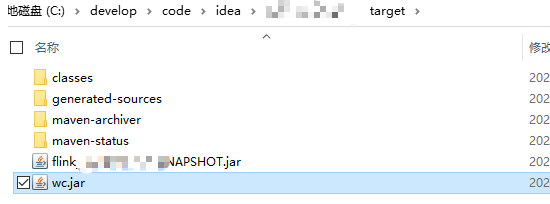
提交
/export/server/flink/bin/flink run -Dexecution.runtime-mode=BATCH -m yarn-cluster -yjm 1024 -ytm 1024 -c cn.itcast.hello.WordCount5_Yarn /root/wc.jar --output hdfs://node1:8020/wordcount/output_xx注意
RuntimeExecutionMode.BATCH//使用DataStream实现批处理RuntimeExecutionMode.STREAMING//使用DataStream实现流处理RuntimeExecutionMode.AUTOMATIC//使用DataStream根据数据源自动选择使用流还是批//如果不指定,默认是流
在后续的Flink开发中,把一切数据源看做流即可或者使用AUTOMATIC就行了
Flink原理初探-慢慢理解/消化
角色分工

执行流程
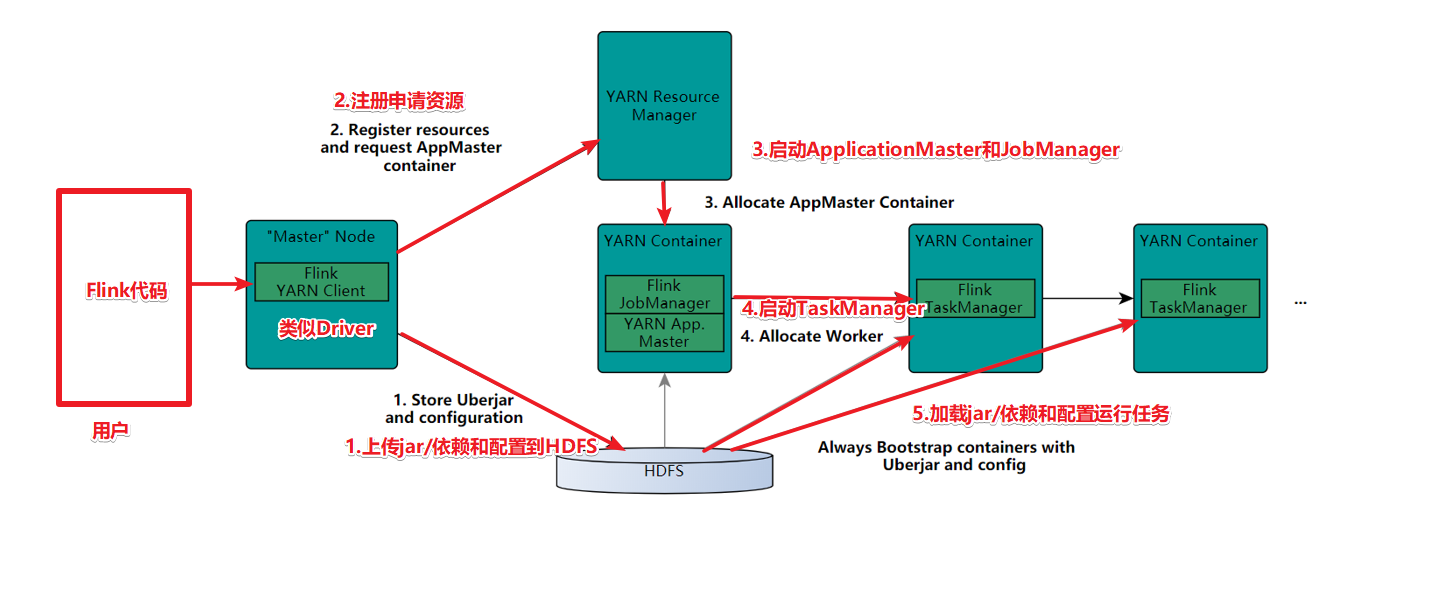
DataFlow
https://ci.apache.org/projects/flink/flink-docs-release-1.12/concepts/glossary.html
DataFlow、Operator、Partition、Parallelism、SubTask
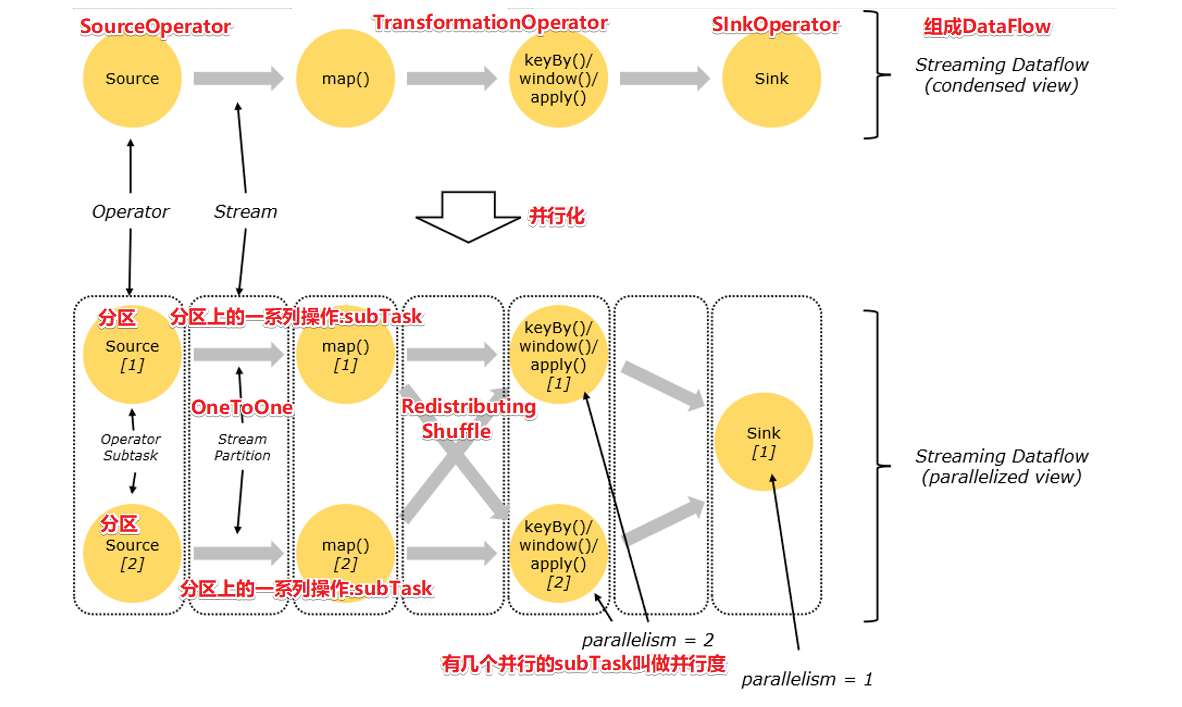


OperatorChain和Task

TaskSlot和TaskSlotSharing


执行流程图生成


公众号:漫话架构之美
大数据领域原创技术号,专注于大数据研究,包括 Hadoop、Flink、Spark、Kafka、Hive、HBase 等,深入大数据技术原理,数据仓库,数据治理,前沿大数据技术




















 1401
1401











 被折叠的 条评论
为什么被折叠?
被折叠的 条评论
为什么被折叠?








